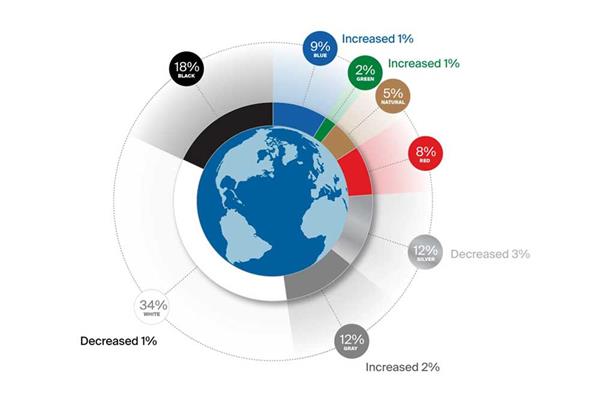
PPG 2020 Automotive Color Popularity Report shows that blue hues – which convey optimism, confidence, recovery and hope – have increased their popularity.
PPG has recently released its 2020 Automotive Color Popularity Report, which shows that blue continues to increase in popularity. The hue symbolizing optimism has reached 9% of global colour share (increasing by 1% from 2019). In Europe, it performs even better, at 11%, and the sales of blue luxury, mid-sized and small vehicles also grew by 1%, as anticipated by PPG’s 2019 automotive colour forecast.
The global COVID-19 pandemic is expected to further fuel the preference for the colour blue.
“COVID-19 has consumers focusing on their desires and priorities. Blue is an optimistic, comforting colour that conveys trust, dependability, confidence, healing and hope. It’s also associated with nature, cleanliness and future-forward technology”, explains Misty Yeomans, PPG’s colour styling manager, who also expects the colour to merge into more vivid or desaturated shades. “Digital-inspired aqua-blues combine versatility with a sense of youthfulness and a fresh spirit. Emergence of the electric vehicle (EV) market also will drive growth in vibrant tones and interesting effects, such as colour-shifting colours. We’re also seeing blue used more extensively in trim lines, logos and other accessorizing applications”.
White is still the world’s most popular colour for the automobile sector with 34% of the market share, even if it fell by 1%, while black and red remained respectively at 18% and 8%. Silver instead has faced a slight decrease, dropping to 12%, but grey has risen to 12%. PPG forecasts that it will remain an important core colour, as concrete and stone materials as well as ceramic and metal tones are increasing their popularity. Nature will also play a pivotal role: warmer and more organic tones, which reflect consumer tastes, will align with light tones, including white and silver.
“White colours also reflect consumers’ desire for refined simplicity and versatility in turbulent times,” Yeomans adds. “In addition to the pearl and metallic whites that are already widely popular, we anticipate a new dimension of white stylings in the automotive market that create a warm, sophisticated feel, such as creamy shades of ivory or bone-coloured tints and ceramic effects. White colours are also highly compatible with emerging radar and LiDAR technologies that enable self-driving vehicles. Red is consistent and an important colour space in the automotive market, holding steady at 8% globally. This colour will get a new push with EV start-ups due to its stand-out nature and association with sports car models. Year after year, we see high chromatic reds growing in interest. Effects and finishes that incorporate black tones allow for artistic reveals in the way colour shifts, highlighting hidden undertones and adding a dramatic flair to the possibilities provided by the new pigments and finishes being developed within this colour family.”